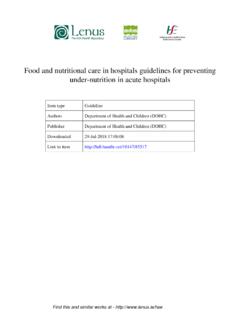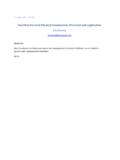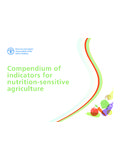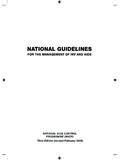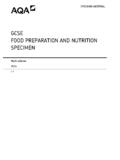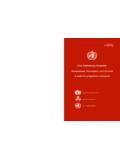Transcription of Guidelines for assessing nutrition-related …
1 Guidelines for assessing nutrition - related knowledge , attitudes and Practices manual Guidelines for assessing nutrition - related knowledge , attitudes and Practices manual by Yvette Fautsch Mac as , FAO nutrition Consultant with Peter Glasauer FAO nutrition Division Food and Agriculture Organization of the United Nations, Rome, 2014. The designations employed and the presentation of material in this information product do not imply the expression of any opinion whatsoever on the part of the Food and Agriculture Organization of the United Nations (FAO) concerning the legal or development status of any country, territory, city or area or of its authorities, or concerning the delimitation of its frontiers or boundaries.
2 The mention of specific companies or products of manufacturers, whether or not these have been patented, does not imply that these have been endorsed or recommended by FAO in preference to others of a similar nature that are not mentioned. The views expressed in this information product are those of the author(s) and do not necessarily reflect the views or policies of FAO. ISBN 978-92-5-108097-9 (print). E-ISBN 978-92-5-108098-6 (PDF). FAO, 2014. FAO encourages the use, reproduction and dissemination of material in this information product. Except where otherwise indicated, material may be copied, downloaded and printed for private study, research and teaching purposes, or for use in non-commercial products or services, provided that appropriate acknowledgement of FAO as the source and copyright holder is given and that FAO's endorsement of users' views, products or services is not implied in any way.
3 All requests for translation and adaptation rights, and for resale and other commercial use rights should be made via org/contact-us/licence-request or addressed to FAO information products are available on the FAO website ( ) and can be purchased through For comments, questions, and additional information, please contact: The Director nutrition Division Food and Agriculture Organization of the United Nations (FAO). Viale delle Terme di Caracalla, 00153 Rome, Italy E-mail: Fax: + 39 0657054593. To obtain the electronic version of the manual and the KAP model questionnaires in MS Word format please go to: Cover photo: Interviewing a caregiver in Otdar Meanchey, Cambodia. FAO/Yvette Fautsch Mac as Contents Acknowledgements vi 1 Introduction 1.
4 Background 1. Why was this manual prepared? 1. What does this manual provide? 2. How should you use this manual? 2. How was this manual prepared? 3. 2 Concepts and purpose of KAP surveys 4. Terminology 4. Purpose 5. Situation analysis for intervention planning 5. Outcome evaluation 6. Key indicators: knowledge , attitudes and practices 8. knowledge 8. attitudes 10. Practices 18. 3 Planning and conducting KAP surveys 27. Activities to undertake before conducting a KAP survey 27. Designing the survey questionnaire 27. Translating the survey questionnaire 38. Training the surveyors 39. Pre-testing the survey questionnaire 42. Sampling the survey population 45. Collecting data: procedures for administering the survey questionnaire 47.
5 4 Analysing the data and reporting the results 52. Cleaning and entering the data 52. Analysing and using the results 53. Sociodemographic characteristics 53. Situation analysis for intervention planning 53. Outcome evaluation 56. Putting the results into context 57. Reporting the results 60. References 64. iii Appendixes 69. Appendix 1: Visual support to measure attitudes 69. Appendix 2: Readiness to change 70. Appendix 3: Informed consent form and sociodemographic questionnaire for caregivers of infants and young children (0 6 months and 6 23 months) 71. Appendix 4: Informed consent form and sociodemographic questionnaire for school-aged children 74. Appendix 5: Informed consent form and sociodemographic questionnaire for adults (> 18 years) 76.
6 Appendix 6: nutrition - related KAP model questionnaires 78. Module 1: Feeding infants (0 6 months) 78. Module 2: Feeding young children (6 23 months) 89. Module 3: Diet of school-aged children 100. Module 4: nutrition during pregnancy and lactation 107. Module 5: Undernutrition 113. Module 6: Iron-deficiency anaemia 118. Module 7: Vitamin A deficiency 129. Module 8: Iodine deficiency 137. Module 9: Food safety 142. Module 10: Personal hygiene 149. Module 11: Water and sanitation 155. Module 12: Food-based dietary Guidelines 161. Module 13: Overweight and obesity 167. Appendix 7: Examples of possible nutrition strategies for low KAP indicators 175. Appendix 8: Qualitative methods basic information on data collection and analysis 178.
7 Iv Guidelines for assessing nutrition - related knowledge , attitudes and practices - KAP Manual Tables Table 1: Examples of short-, medium- and long-term outcomes of nutrition interventions that include an educational component 7. Table 2: Health and nutrition - related attitudes 18. Table 3: Approaches used to measure dietary diversity, intake of specific foods, frequency of intake of specific foods and specific observable behaviours and the purposes for which they are used 25. Table 4: Overview of general and nutrition - related characteristics of children of three age categories 33. Table 5: Suggested threshold levels indicating the need for a nutrition -education intervention 54.
8 Table 6: Factors that affect the results of a survey or study used in a situation analysis or outcome evaluation 58. Table 7: Sampling strategies and their impact on interpretation of survey data 59. Figures Figure 1: Situation analysis and outcome evaluation 5. Figure 2: Guatemala Food Guide 15. Figure 3: Flowchart for defining survey objectives, survey population and selecting topics to cover for an outcome evaluation 29. Figure 4: Social, environmental and intrapersonal factors affecting practices 56. Boxes Box 1: attitudes three or five-point scale? 12. Box 2: Measuring infant and young-child feeding practices 20. Box 3: Tips for selecting interviewers 39. Box 4: Pre-testing debriefing: points to check with surveyors 45.
9 Box 5: Planning a KAP survey: summary 46. Box 6: Limitation of KAP surveys 51. Acronyms DDS Dietary diversity score FBDG Food-based dietary Guidelines FFQ Food frequency questionnaire KAP knowledge , attitudes and practices UNICEF United Nations Children's Fund WHO World Health Organization Contents v Acknowledgements The authors are grateful to all of those who contributed to the development of this manual. Many people reviewed the first draft of the model questionnaires presented in Appendix 6, including Catherine Bessy (FAO Headquarters), Lalita Bhattacharjee (FAO Bangladesh), Florence Tonnoir (FAO Gabon), Shubhada Kanani (Network for nutrition Awareness and Advocacy [NETNAA] India) and Pauline Samuda (Caribbean Food and nutrition Institute, University of the West Indies, Jamaica).
10 Their comments and suggestions contributed to improving the questionnaires. The questionnaires were field-tested and validated in several countries; Delhi Anah Trejo Hern ndez, Graciela Raya Giorguli, Estela Herrera Martignon, Jenifer Guerrero Morales and Elia Irene Corzo N jera from the PESA Programme (Programa Especial para la Seguridad Alimentaria) in Mexico; Ana Elizabeth Hern ndez Marroquin, Cindy Elena and Rose Marie Rivas in El Salvador; Solange Heise in Malawi; and Yvette Fautsch Mac as in Cambodia. These nutritionists trained and supervised enumerators, reported the results and modified the questionnaires accordingly. This process ensured that the questionnaires were valid, readable, easy to administer and were not burdensome for respondents.










